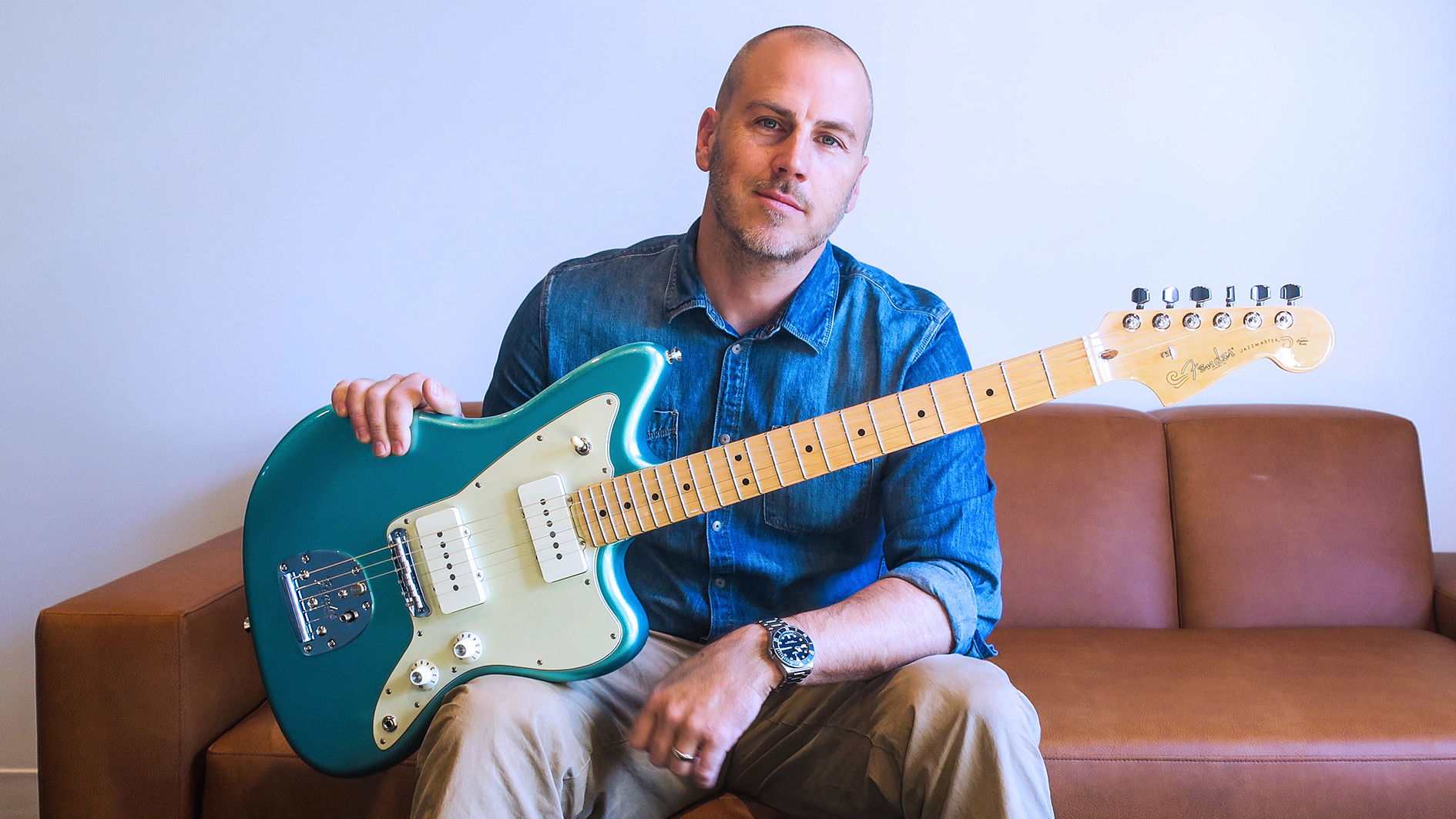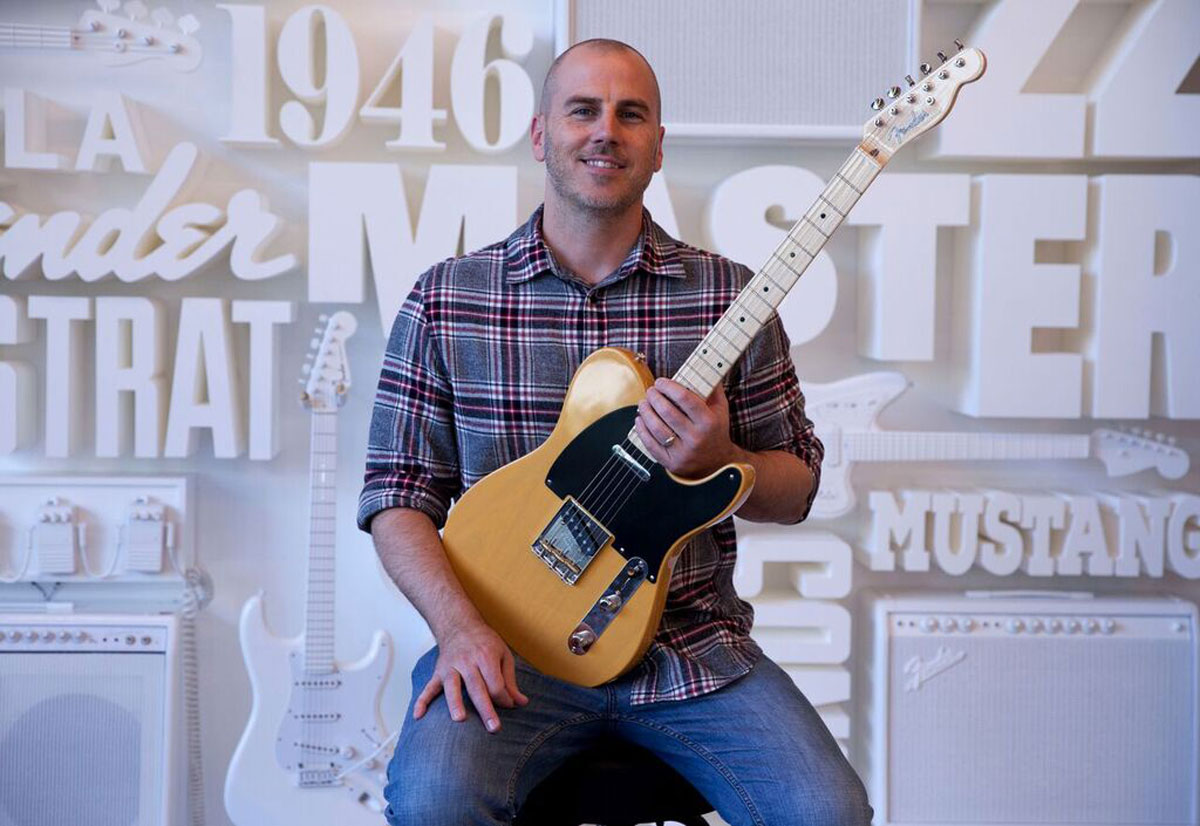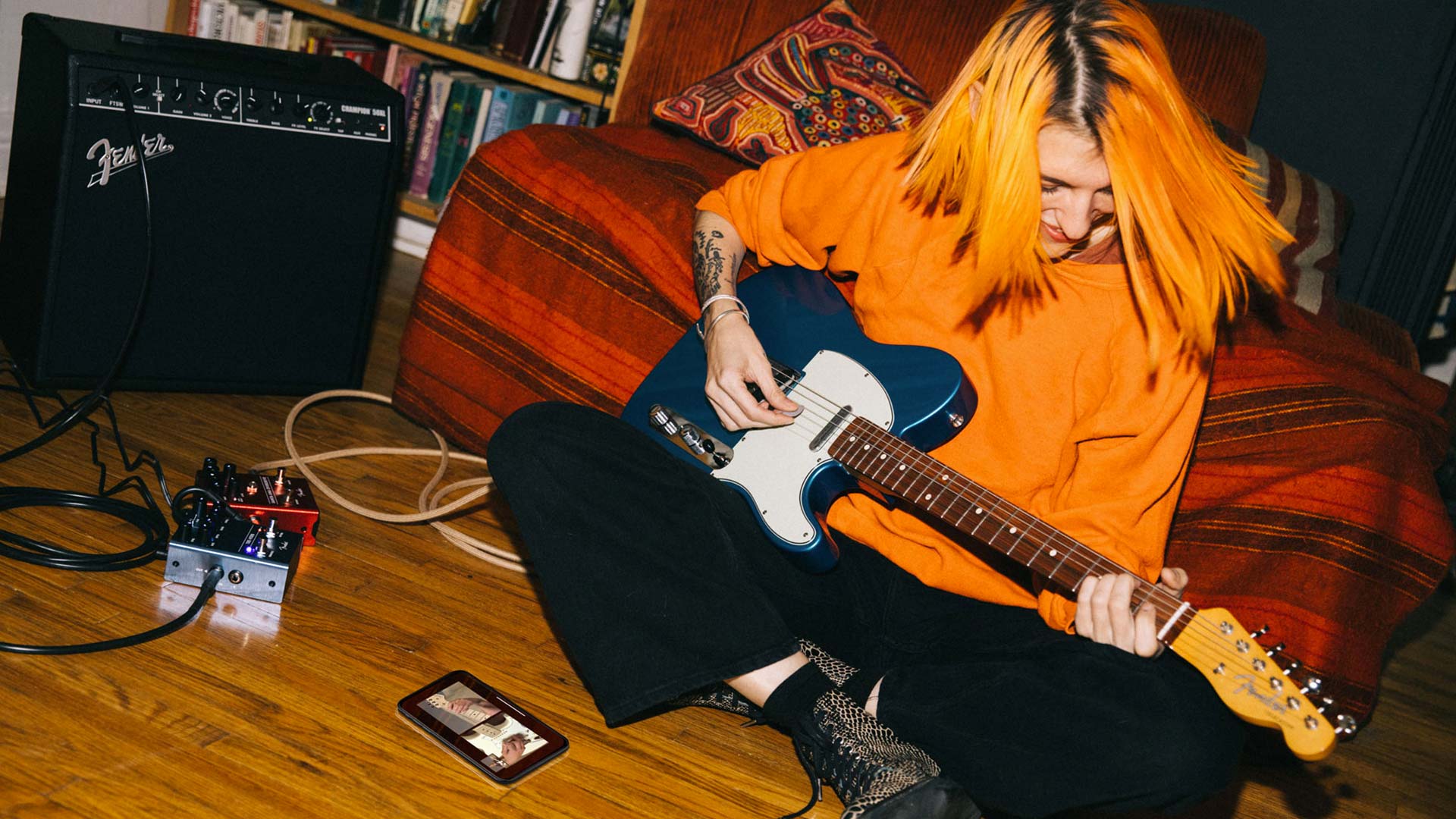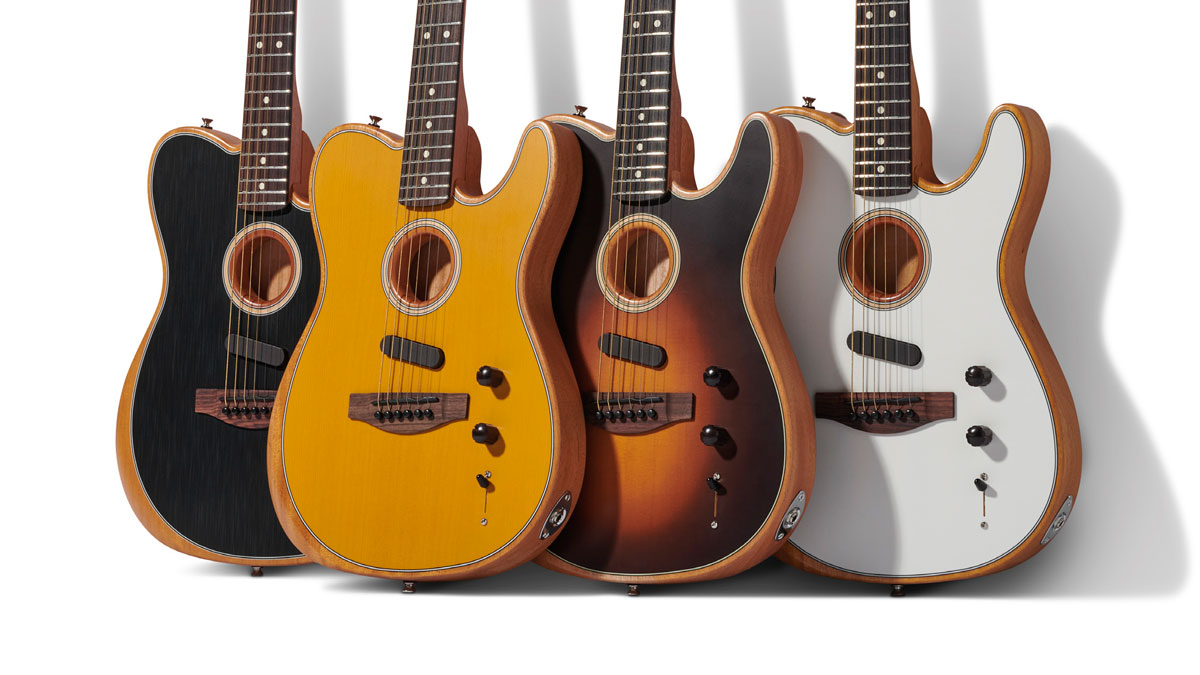Fender's Justin Norvell: “There's been a big rediscovery of what a guitar can be. More people understand how it can become an extension of one's self”
The Big F's EVP on guitar trends in 2022, what gear to expect from the brand this year, and why there's never been a better time to pick up the instrument

While on one hand we are living in some of the strangest times in modern history, with nearly every industry around the world affected by the ongoing pandemic – particularly the live music sector, which has endured more than its fair share of disruption from cancellations and postponements – there’s also the sense that guitar has never more alive as an instrument.
What was once erroneously perceived as a working tool for rock and roll dinosaurs now embodies so much more, even to those who don’t play it. Whatever kind of band you see on stage, from dance groups to pop acts and beyond, there will usually be a guitar somewhere – whether it’s performed live or sampled.
As any guitarist will tell you, it’s an instrument that’s always been deeply embedded into popular culture. Perhaps what’s changed is that right now, to outsiders, the guitar has never felt more visible and prominent, which is why sales in certain corners have rocketed and products have multiplied.
For younger creatives, many of whom started their six-string journey over lockdown, it’s become a medium for self-expression that they can document and share as they go – with more communities to do it with and more tools to help them along the way. As a result, notes Fender Product EVP Justin Norvell, early expectations for new learners are vastly different than to times before.
“Even beyond the dynamics of the pandemic and people being at home, I think the idea of being a professional anything has changed over the years,” says Norvell, pointing out the wider cultural shift.
“If you wanted to be a videographer, you’d have to go to school and learn how to do it for that trade. Nowadays people just get to the app on their phones and they can upload things straight to social media platforms. Music is just the same.

“I remember talking to [Dinosaur Jr.'s] J Mascis years ago and asking what advice he’d offer to anyone starting out. And his answer, which was kinda provocative at the time, was, ‘Get in a band before you can even play!’
Get The Pick Newsletter
All the latest guitar news, interviews, lessons, reviews, deals and more, direct to your inbox!
“He felt that’s the best way to do it, learn as you go so it was a bit raw, rough and ready. The old idea of taking lessons for several years until you’re ready to play with others, waiting until you can put a band together, then eventually taking your music out to the world has been blown up.
“Now someone can get a guitar and start recording straight away, editing and producing music that sounds good to them. It feels like things have exploded for guitar. It may have typically lived in certain boxes, but that’s not necessarily the case anymore.”
A lot of barriers have been removed as far as what someone can do with a guitar and what the expectations for year one can look like for someone
Technology has played a big part in that. The musicians of today don’t even need a local teacher to learn or a band/studio to create their masterpiece. It can all be done, should they wish, from the comfort of their own homes and at very little expense. Those who want to get going can do so swiftly and smoothly.
“You have EZDrummer, intelligent AI and things like the [DigiTech] Trio Band Creator + Looper which can help creativity come a lot faster,” continues Norvell. “A lot of barriers have been removed as far as what someone can do with a guitar and what the expectations for year one can look like for someone.
“We’re finding out things through Fender Play and our player's groups on Facebook. When I started out, most people learning wouldn’t want to play in front of anyone for quite some time. But now people are very eager to video themselves playing their first song or their first chords and share that with everybody.
“And things like that create a community for the instrument. When you play a sport, you’re doing it with people. Guitar is generally learned at home and by yourself, so we’re taking what can normally be a solitary activity and turn it into a shared experience where you can see others just like you in order to inspire. That makes people want to continue their journey.”

What trends have you noticed over the last year or so?
“We’ve seen a lot of clean guitar. There’s still metal, rock and all those genres, but we’ve seen more guitar on a poppy level. After Mac DeMarco came out in the indie world six or seven years ago, there’s been a lot of that heavy reverb, surfy, warbly and jangly stuff out there.
“Then you’ve got the neo-soul movement. There are different corners: you’ve got revivalists like Black Pumas and Silk Sonic, who I love, and then there’s the whole Pickup [Music] jazz movement with your Tom Mischs, Vulfpecks and all of that.
“Guitar has really moved out in every single direction from the center. It doesn’t matter if you’re a hip-hop artist or a rock artist, it’s just there, being rediscovered as the most expressive of modern instruments.
“I think it was David Gilmour in a BBC interview who said you can hit a C on a piano, but on guitar it’s all about the way you attack with the pick, what your vibrato sounds like, how hard you press… there are hundreds of nuances that bring something extra to that note.
People might sit at a computer or a sequencer and work, then pick up a guitar next and it’s the guitar that feels like it matters most
“I feel like right now there’s been a big rediscovery of that, the human aspect of what a guitar can be. People might sit at a computer or a sequencer and work, then pick up a guitar next and it’s the guitar that feels like it matters most. More people understand how it can become an extension of one’s self.”
There are so many different elements of a guitar player’s personality that come out through vibrato, bends and touch before you even get to the note choices…
“Exactly. Some players are a little behind, lazy and slow while others feel urgent and fast. You can recognize who is playing by how aggressive or passive they are. There’s so much personality in guitar – you can hear two notes of a player and know instantly who that is.
“These days, people aren’t necessarily looking to be just a guitar player. I have a musician son – he’s got an [Akai] MPC on his desk, then he’ll switch to guitar, then the bass will be on his lap or he’ll start doing stuff in the box.
“It’s much more multidisciplinary these days, I guess. There’s a cavalcade of one-person bands out there. That expands the possibilities for guitar. Anyone that’s recording and using synths, for example, will start looking at the guitar and bass as natural extensions of that.”

What else will you remember about 2021?
“An amplifier is not a black box on the floor with a speaker in it anymore. Look at the Mustang Micro and its success, which has been fantastic. There are a myriad of ways to get your tone – you might use something like a Mustang Micro or you might go through an interface and into a plugin, and those plugins have gotten very good.
“Our options for what to do with our guitars have really opened up. That’s why we merged with PreSonus at the end of last year. We want to solve problems for musicians and give them tools to be creative. We see that this is not a different thing to guitar – it’s something guitars are being plugged into, as well as other instruments.”
The Tone Master Super Reverb was also an interesting re-imagination of what a Fender amp could be…
“We wanted to turn the concept of modeling on its head with our Tone Master series. If you’ve got a modeling amp, you’ll have a processor that can handle X amount of power and do X amount of things. The usual idea is to make an amp that can do as many of those things as possible – they might have 200 sounds and a bunch of effects all in one.
People who record are always looking for new tools and the Bass VI can be like this whole new universe of sound
“With the Tone Masters, we thought, ‘Let’s use all of that processing power to make the one great sound, with perfect reverb and real tube amp-style response!’ That’s not detracting from the multi-effects kind of amp, because they are very convenient and can sound great, too.
“Everyone has a different thing they’re looking for, but the nuances are very important to tone aficionados. We wanted to continue being at the forefront of what a digital amp is, but not necessarily one with a laundry list of what it can do. We wanted our digital to focus more on getting the tone of your beloved tube amp.”
There was a lot of Fender gear seen in the footage from last year’s The Beatles: Get Back documentary. Did that spike extra interest in certain models?
“In the annals of history, people have talked about a black panel amp or a silverface, and which one’s superior. In Get Back, you see The Beatles all playing through a silverface! There was a rosewood Tele in there, too. But the funniest thing from all that was that the phone started ringing off the hook for the Bass VI, because it was popping in and out of certain scenes.
“People were like, ‘You know, I haven’t thought about this in years, but do you have any of those in?’ And luckily we did, through Squier. People who record are always looking for new tools, and the Bass VI can be like this whole new universe of sound. Even down to the Fender PA in Get Back, it was great to see.”

Though you’re a company with such rich heritage, it’s interesting how you’re still trying out new things – the Parallel Universe series and Acoustasonic range being perfect examples of that...
“It’s important to us. Even though we emerged from the '50s and '60s with the Strat, the P [Bass], the [Jazz Bass], the Jazzmaster et cetera, there were still so many other things. Leo was always tinkering! People talk about a Deluxe and a Twin, but there was also a Harvard. There were lots of other things.
“That’s why we came up with things like the Paranormal series, the Troublemaker Tele and the Meteora – continuing that tradition and not just making what we’ve always made. It’s that idea of embracing anything that’s not typically what we do, like the Mustang Micro, because we normally make these tolex or tweed tube amps that are loud. We want to adapt with the times and move forward without being afraid to fail.
There’s nothing like new gear to inspire people. New songs will come from new guitars and amps. We felt like it was our duty to continue with the flow of the new and foster that inspiration for players
“When I look back over the Fender books, I’m fascinated by things like the Swinger, the Starcaster and the Maverick. It all adds to the history and legacy of the company – one who dares to try to dream.
“Being in the Products group, that’s something we instill in everybody. The only rule is that there are no rules. We still have all the stuff for the people who want us to stay the way we used to be, but we can also keep pushing forward.”
What else can we expect from Fender over the year ahead?
“Let’s just say the Get Back movie was well-timed for some things that we have coming! There’s some more excitement coming with the Player Plus. We’ve got new stuff in every category, from Fender to Squier and electrics to acoustics – there was no department at Fender that took it easy last year.
“There are some fantastic artist models coming up over the next year, too. Some of that funk and neo-soul stuff I mentioned before will line up with that.
“Continuing to have new products coming out and new tools for people to use has been important to us. There’s been a lot going on behind the scenes, from chip shortages to freight delays. It’s been a hectic time, but we very seriously decided to continue giving people those tools.
“There’s nothing like new gear to inspire people. New songs will come from new guitars and amps. We felt like it was our duty to continue with the flow of the new and foster that inspiration for players.”
Amit has been writing for titles like Total Guitar, MusicRadar and Guitar World for over a decade and counts Richie Kotzen, Guthrie Govan and Jeff Beck among his primary influences as a guitar player. He's worked for magazines like Kerrang!, Metal Hammer, Classic Rock, Prog, Record Collector, Planet Rock, Rhythm and Bass Player, as well as newspapers like Metro and The Independent, interviewing everyone from Ozzy Osbourne and Lemmy to Slash and Jimmy Page, and once even traded solos with a member of Slayer on a track released internationally. As a session guitarist, he's played alongside members of Judas Priest and Uriah Heep in London ensemble Metalworks, as well as handled lead guitars for legends like Glen Matlock (Sex Pistols, The Faces) and Stu Hamm (Steve Vai, Joe Satriani, G3).
“I suppose I felt that I deserved it for the amount of seriousness that I’d put into it. My head was huge!” “Clapton is God” graffiti made him a guitar legend when he was barely 20 – he says he was far from uncomfortable with the adulation at the time
“I was in a frenzy about it being trapped and burnt up. I knew I'd never be able to replace it”: After being pulled from the wreckage of a car crash, John Sykes ran back to his burning vehicle to save his beloved '76 Les Paul










